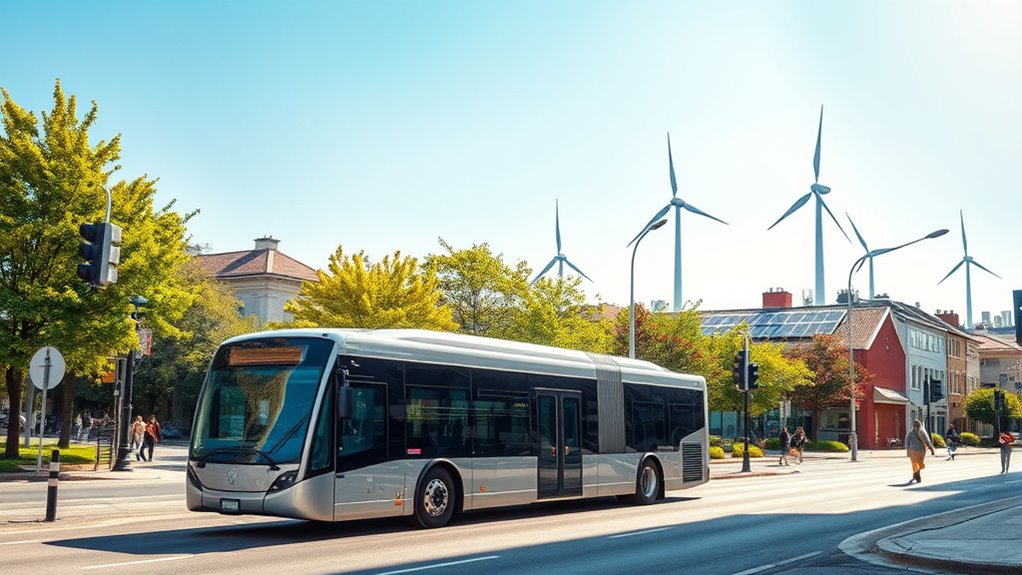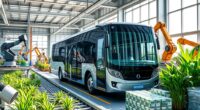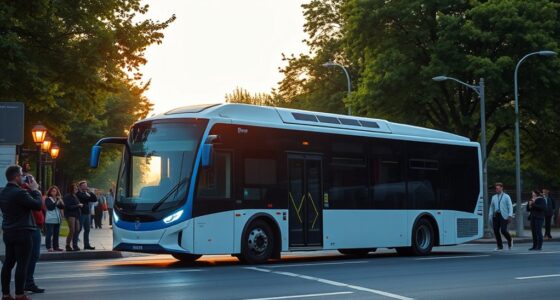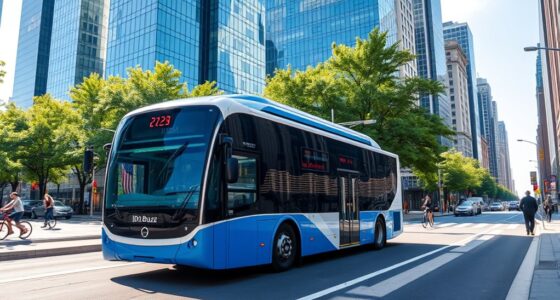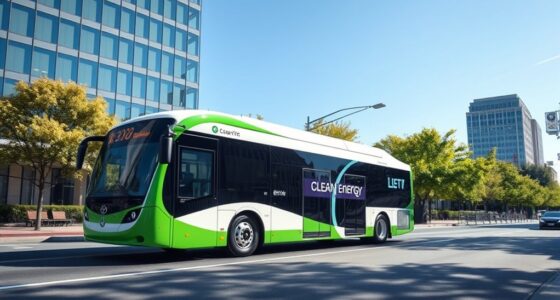Electric buses powered by renewable energy offer a compelling path to cleaner, quieter cities. They cut emissions, reduce noise, and lower reliance on fossil fuels when paired with solar, wind, or green storage. Innovations like fast and wireless charging make operation smoother and more flexible. With strong policies and investments, cities worldwide are already embracing this eco-friendly shift. Curious about how these technologies and strategies work together? Keep exploring to see how this perfect match is reshaping urban transit.
Key Takeaways
- Renewable energy-powered electric buses significantly reduce greenhouse gas emissions and urban air pollution.
- Integration with solar, wind, and green storage makes electric buses nearly carbon-neutral.
- Advanced charging technologies and smart grids optimize energy use and infrastructure efficiency.
- Policy support and funding accelerate the deployment of renewable-powered electric bus fleets.
- Technological innovations enhance battery life and charging speed, making sustainable transit more feasible.
The Environmental Benefits of Electric Buses and Renewable Energy

Electric buses offer significant environmental benefits that make them a sustainable transportation choice. They produce zero tailpipe emissions, helping cut greenhouse gases and pollutants that harm public health. This leads to better urban air quality and fewer respiratory issues.
Compared to diesel buses, electric models emit about 181 fewer metric tonnes of CO2 annually, aiding climate change efforts. Their quieter operation reduces noise pollution, improving city living conditions.
When powered by renewable energy like solar or wind, electric buses become nearly carbon-neutral, further lowering environmental impact. They also decrease dependence on fossil fuels and support green infrastructure development. Renewable energy integration is crucial for maximizing these benefits and ensuring a sustainable transportation future. Additionally, advancements in battery technology are enhancing the range and efficiency of electric buses, making them more viable for widespread adoption.
In addition, integrating heat pump technology with renewable energy sources can optimize energy efficiency in urban systems, further supporting sustainable transportation initiatives.
Over time, using renewable energy with electric buses can lower operational costs and promote sustainable urban mobility, aligning transportation with broader environmental and public health goals.
Innovations in Charging Technologies and Smart City Integration
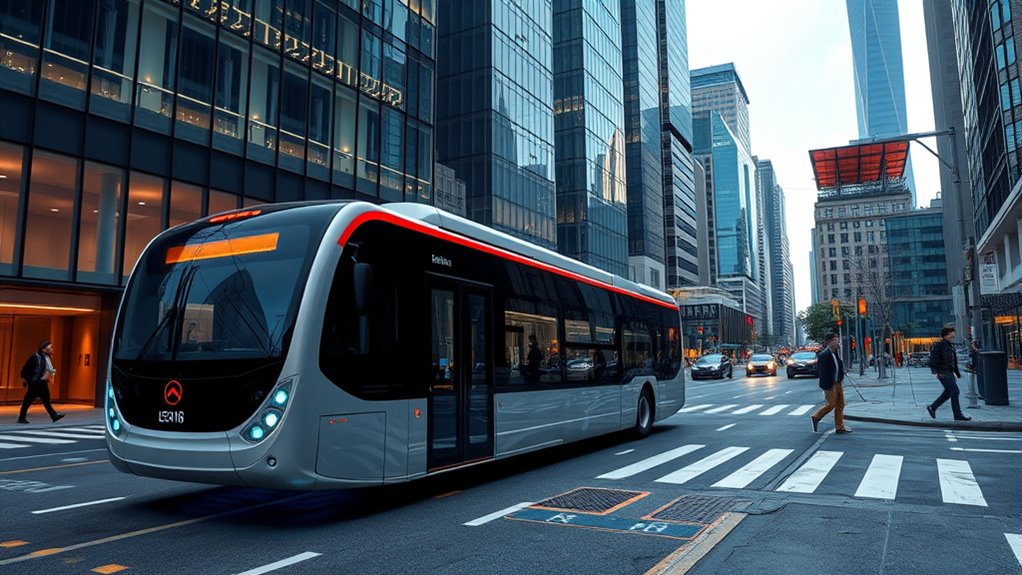
Innovations in charging technologies are transforming how cities support electric bus fleets, making operations more efficient and sustainable. Advanced battery designs boost capacity, efficiency, and lifespan, enabling longer routes and higher passenger loads.
Innovative charging tech boosts electric bus capacity, efficiency, and lifespan for more sustainable urban transit.
Fast charging solutions allow buses to recharge quickly during short stops, minimizing downtime, while wireless charging using inductive technology removes the need for physical connectors, streamlining operations. Conductive charging with pantographs offers rapid in-transit recharging, increasing route flexibility.
Integrating energy storage reduces costs and enhances system efficiency. Smart city features like vehicle-to-everything (V2X) communication and managed charging optimize traffic flow and balance demand. Remote hackathons can be utilized to develop innovative solutions for smart city infrastructure and electric vehicle integration. Incorporating renewable energy sources such as solar and wind power can be harnessed to supply clean energy for charging stations, reducing the carbon footprint of electric bus fleets. Infrastructure upgrades—such as dedicated lanes and charging stations—support seamless electric bus operations. Additionally, incorporating high contrast ratios in display systems can facilitate better real-time information displays for passengers and operators. Developing advanced data analytics can further optimize route planning and energy consumption. These innovations collectively reduce urban disruptions and promote sustainable, reliable transit systems.
Energy Management Strategies for Sustainable Urban Transport
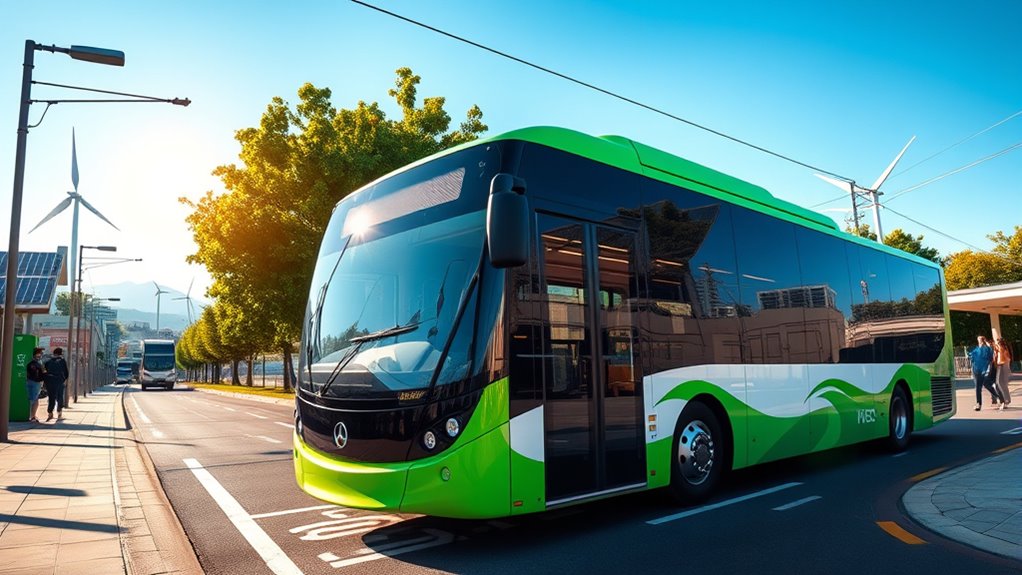
Effective energy management is essential for creating sustainable urban transport systems that minimize environmental impact and optimize resource use. You can achieve this by adopting strategies like optimizing public transit routes and schedules to reduce energy consumption. Incorporate vehicles powered by alternative fuels, such as biofuels or hydrogen, to cut emissions and boost efficiency. Utilize electric trams and trains to ease congestion and lower carbon footprints. Implement smart traffic management systems to reduce congestion and save energy. Integrate renewable energy sources, like solar-powered charging stations, wind energy, and green energy storage, to power electric buses and infrastructure. Additionally, designing compact, interconnected cities reduces travel needs. These strategies work together to create a more sustainable, energy-efficient urban transportation network aligned with renewable energy goals. Leveraging renewable hydrogen for public transit fleets can further enhance sustainability and reduce reliance on fossil fuels. Employing advanced energy storage solutions can also help manage fluctuations in renewable energy supply, ensuring a stable power source for transit systems. For example, incorporating energy storage systems can help balance supply and demand, improving overall system efficiency.
The Role of Policy and Funding in Promoting Renewable-Powered Buses
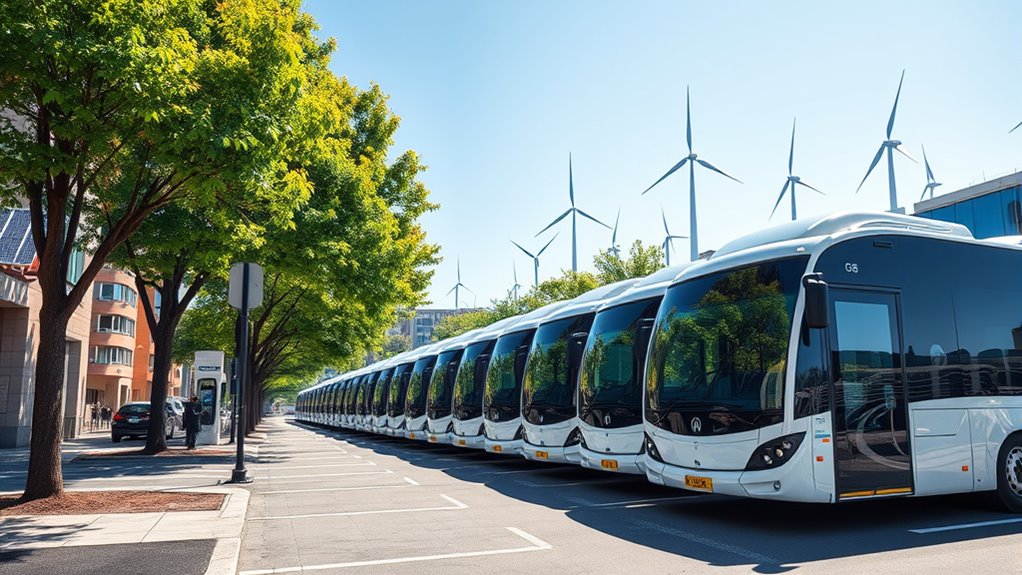
Government policies and funding play a pivotal role in advancing renewable-powered buses within urban transportation systems. Legislation like the Bipartisan Infrastructure Law allocates significant funds to support electric bus progression, while emission reduction goals encourage agencies to adopt cleaner options.
Federal grants, such as those from the Federal Transit Administration, and programs like the Clean School Bus Program, provide essential financial support. State, local, and public-private partnerships further boost funding, helping to develop charging infrastructure, solar-powered facilities, and modernize fleets. These investments enable workforce training and facility upgrades, making electric buses more practical. Additionally, the increased interest in alternative investments amid market volatility can influence funding priorities and innovation in transportation technology. Furthermore, fostering public acceptance through education campaigns is vital for widespread adoption of renewable transit solutions. Promoting community engagement can build trust and support for these initiatives, ensuring long-term success. Recognizing the importance of renewable energy integration can also accelerate the deployment of sustainable transportation options, creating a more resilient and eco-friendly urban environment.
Case Studies: Successful Implementations of Renewable Energy and Electric Buses
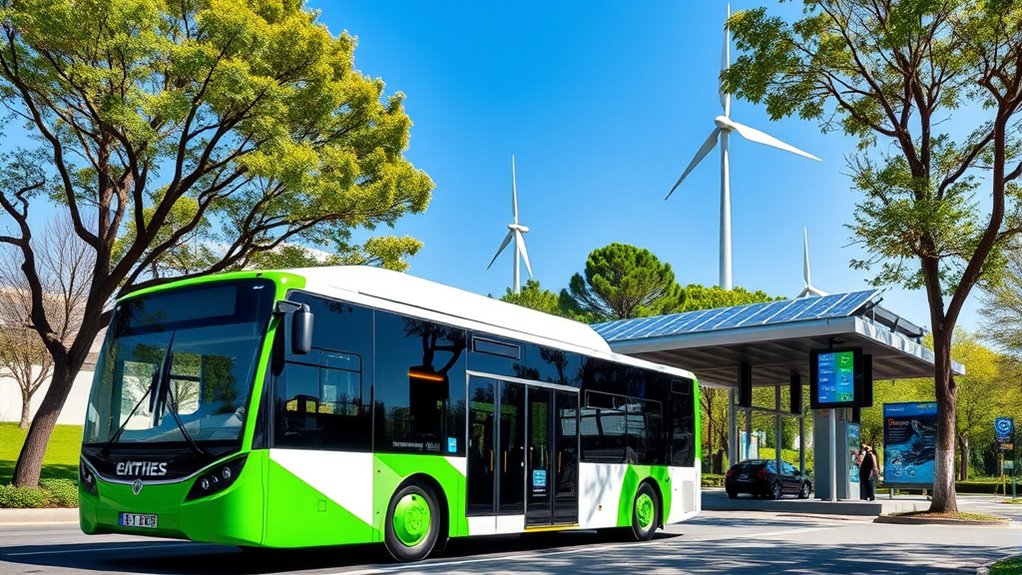
Numerous cities and organizations have successfully integrated renewable energy with electric bus systems, demonstrating practical pathways to cleaner transportation. For example, the EPA showcases case studies of clean school bus projects across the U.S., highlighting how renewable sources power electric buses.
In Germany, VLP has electrified 22% of its fleet with buses charged from renewable energy, drastically cutting emissions. South Africa’s Golden Arrow Bus Services has tested and deployed electric buses for daily routes, using renewable power for charging.
These projects benefit from innovative charging infrastructure, including on-site solar-powered stations, dynamic and opportunity charging, and wireless systems that improve efficiency and reduce wear. Such implementations lower operational costs, reduce pollution, and showcase how renewable energy can seamlessly support sustainable public transportation.
Future Outlook: Advancing Sustainable Transportation Through Clean Energy
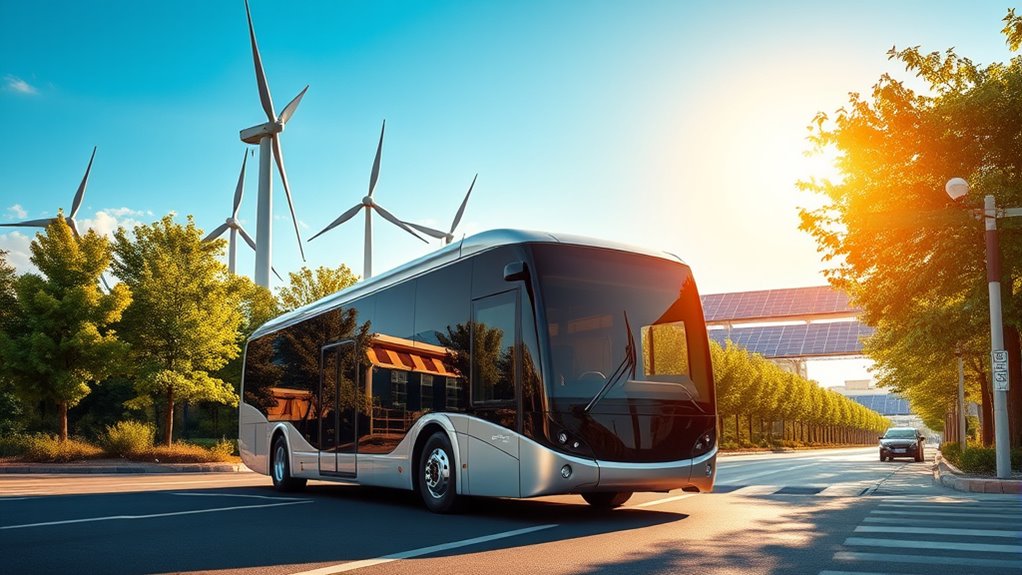
The future of sustainable transportation is increasingly driven by the rapid adoption of electric buses powered by renewable energy. You’ll see global electric vehicle sales surge, with light-duty vehicles reaching 40% market share by 2030. Municipal buses are electrifying fast worldwide, offering cleaner, quieter, and cost-effective transit.
Renewable energy can power these buses, reducing reliance on fossil fuels and cutting carbon emissions. Technological advances, like better batteries and faster chargers, will boost efficiency and lower costs.
Integration with smart grids and energy storage solutions will help meet rising electricity demand. While infrastructure investments and grid capacity pose challenges, policies and incentives are pushing forward.
Frequently Asked Questions
What Are the Main Challenges in Integrating Renewable Energy With Electric Bus Systems?
The main challenges in integrating renewable energy with electric bus systems include managing increased grid demand, ensuring grid stability, and upgrading infrastructure costs.
You’ll face delays in smart grid deployment, unpredictable renewable output, and land use conflicts at depots.
Additionally, coordinating between agencies, handling high-capacity charging needs, and addressing battery lifespan issues complicate the process.
Regulatory hurdles and high upfront investments also slow down widespread adoption, making seamless integration tough.
How Do Vehicle-To-Grid Technologies Impact Grid Stability and Energy Costs?
Vehicle-to-grid (V2G) tech boosts grid stability by allowing your electric vehicle’s battery to supply power back during high demand, reducing blackouts.
It also cuts energy costs by shifting usage off-peak and selling excess energy.
When integrated with renewable sources, V2G helps store clean energy and releases it when needed, making the entire system more resilient, efficient, and environmentally friendly.
This benefits everyone involved.
What Are the Long-Term Maintenance Costs of Renewable-Powered Electric Bus Depots?
You might wonder about the long-term maintenance costs of renewable-powered electric bus depots. Over time, expenses include maintaining charging infrastructure, energy management systems, and depot modifications.
While initial investments are high, you’ll save on fuel and reduce operational costs. Regular upkeep of renewable energy systems, such as solar panels or wind turbines, is essential, but these costs are typically lower than ongoing fuel expenses.
Making the depot more sustainable and cost-effective in the long-term.
How Do Policy Incentives Vary Across Different Regions for Electric and Renewable Energy Projects?
You see policies shifting like a steady tide, varying across regions to support clean energy. Federal programs offer grants covering up to 100%, while states add their own incentives, like Texas’ infrastructure grants. Utility companies provide financing options.
Some regions prioritize disadvantaged communities. These regional differences create a patchwork of support, helping you adopt electric and renewable projects more easily, fostering growth and innovation across diverse landscapes.
What Technological Advancements Are Expected to Further Improve Electric Bus Efficiency?
You’re curious about how tech advances will boost electric bus efficiency. Expect solid-state batteries for higher energy density and safety, plus lithium-sulfur ones that are lighter and offer longer range.
Modular systems let you replace parts easily, while ultra-fast chargers and wireless options cut downtime.
AI route planning, regenerative braking, and lightweight materials will optimize energy use, making your electric bus more reliable, eco-friendly, and cost-effective.
Conclusion
By embracing renewable energy and electric buses, you pave the way for cleaner air, quieter streets, and a healthier planet. You drive innovation through smarter charging, smarter policies, and smarter urban planning. You create sustainable transportation that reduces emissions, boosts efficiency, and fosters resilient communities. Together, you can turn these technologies into a powerful movement—fueling progress, protecting the environment, and shaping a brighter, greener future for everyone.
